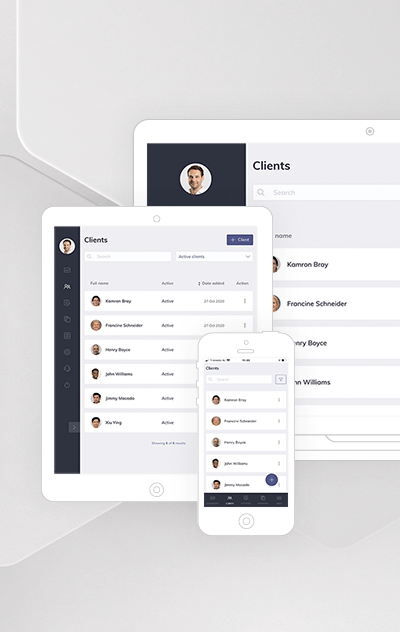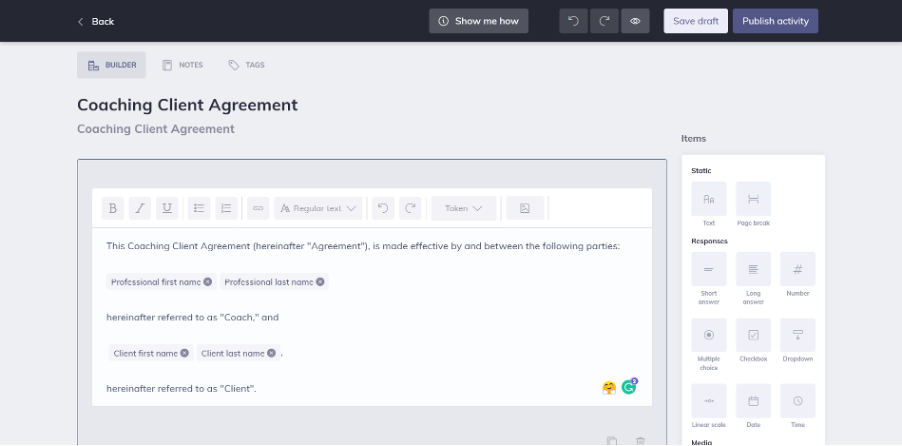How to Send & Build Counseling Client Intake Forms Digitally
 The intake process is the first part of the journey to positive mental health outcomes for those entering counseling.
The intake process is the first part of the journey to positive mental health outcomes for those entering counseling.
Done well, it provides a fast track to learning essential information about the patient before their first counseling session (Beck, 2011).
While traditional paper intake forms are critical to forming a picture of who patients are, their situation, and their problems, new dedicated online platforms offer powerful digital alternatives.
This article explores the importance of intake forms and the potential for using dedicated online platforms to build and send digital forms to the client.
Before you read on, we thought you might like to download our three Positive Psychology Exercises for free. These science-based exercises explore fundamental aspects of positive psychology, including strengths, values, and self-compassion, and will give you the tools to enhance the wellbeing of your clients, students, or employees.
This Article Contains:
What Is an Intake Form in Counseling? An Example
The client intake form is an essential part of the intake process of therapy and underpins a successful and fruitful therapeutic alliance between the healthcare professional and their client. Such a relationship is vital, as it impacts the ongoing assessment and treatment of the client and the overall outcome of counseling (DeAngelis, 2019).
For the counselor or therapist, the client intake form does more than provide information on who the client is and their current situation; it suggests a structure to the initial meeting and a potential course for their counseling journey (Leighton, 2013; Beck, 2011).
Gaining a complete picture of the client early on saves time and builds the client’s trust and confidence in the process of therapy. The intake form is a unique opportunity to gain patient details that would otherwise take too long to acquire during sessions, risking losing momentum and the client’s early motivation to seek help.
Often, the completed intake form feeds into a dedicated intake interview. This initial assessment meeting aims to obtain further information regarding the issues and problems for which the client is seeking help and may include some preliminary discussion on personal and family history (“Intake interview,” n.d.).
“It is desirable to collect as much information as possible before you see the patient for the first time” (Beck, 2011, p. 47). The evaluation session will require less time if the intake form has been completed as much as possible beforehand.
Beck (2011) lists the drivers and goals of this initial assessment session and intake form for Cognitive-Behavioral Therapy; these are true for other therapy and counseling methods as well.
- Formulate the case and create a draft conceptualization of the patient.
- Determine your appropriateness as a counselor.
- Determine if you can offer an appropriate frequency for counseling.
- Understand whether other treatments, including medication, are indicated.
- Begin forming a therapeutic alliance with the patient (and potentially partner and family members).
- Begin to socialize the patient into the therapeutic process.
- Identify key problems and set broad goals for the treatment.
The client intake form is essential; at minimum, it captures basic information such as the client’s address, date of birth, and medical history. The intake form is crucial for record keeping and may prompt conversations in early sessions.
The client’s understanding of the issues they are facing and why they seek therapy is extremely valuable and will also inform early conversations.
So, what is included in the client intake form?
There is no single standard for the client intake form; indeed, it varies from region to region, according to the American Psychological Association (2016) guidelines.
The therapist or counselor is free to design their own for use with their clients, but typically the client intake form will include the following details:
- Patient name
- Medical ID
- Date of birth
- Current age
- Phone number/email
- Address
- Emergency contact
- Insurance information
- Primary care provider
- Reason for referral (if relevant)
- Medical history (physical and mental health)
- Current medication
- Specific physical, mental, and behavioral symptoms
- Reasons why the client is seeking counseling
- Goals for counseling – What is the desired change wished for as a result of counseling?
The mental health professional will be most interested in the final six items on the list, as they have the potential to direct the method and approach of the therapy.
Intake forms can also be customized to include terms of service and formal agreements between the practice/practitioner and the client (American Psychological Association, 2016).
Additional information that may be requested on the intake form includes (American Psychological Association, 2016):
- Preference for face-to-face or online counseling
- Preferred mode of communication (SMS, email, phone)
- Family members with a history of mental health issues and their diagnosis
- Substance abuse history and treatment
- History of abuse or trauma (physical, emotional, mental, or sexual)
- Current life transitions and issues that the counselor should be aware of
Practitioners can also use online platforms such as Quenza to send intake forms. Quenza is a dedicated, well-thought-out online platform that makes it easy to design, change, send, and receive completed intake forms quickly and ensure they are stored securely.
Once a practitioner has created a standard intake form template, they can easily tailor and re-use it with other clients.
10 Benefits of Using Software to Send Intake Forms

The shift toward digital and automated tools improves the ability of mental health professionals to meet the needs of existing clients while having the capacity for a broader reach (Tremain, McEnery, Fletcher, & Murray, 2020).
While paper intake forms undoubtedly remain in many practices, there are a host of benefits to be found from the move to a digital platform, particularly when using dedicated software such as Quenza (Kanatouri, 2020; Ribbers & Waringa, 2015):
- Intake forms can be sent, received, and completed at a time that suits all parties.
- Digital connectivity ensures that intake forms can be communicated immediately or accessed securely on therapy practice websites.
- Forms can be completed from any location with access to the internet, using laptops, tablets, and smartphones.
- Completed forms can be easily accessed by appropriate personnel yet be held securely and backed up to remove the risk of loss or corruption.
- Forms can be designed and built using dedicated technology to ensure they are standardized, practical, and professional looking.
- Online platforms will track the sending and receipt of completed forms.
- Follow-ups and reminders can be automated to chase completion of the form.
- When counseling involves more than one person (for example, couples or family counseling), duplicate forms can be sent concurrently.
- With appropriate consent, information can be shared with other professionals when multiple treatments are required.
- Administrative tasks for the mental health practice are reduced, making more time available for the clients.
The Best Online App for Building & Sending Intake Forms
Mental health treatment is most successful when it is made personal and appropriate to the individual. Such personalization requires detailed knowledge of the patient and begins with the client intake form.
Therapy intake forms are typically one of the first, and one of the most important, steps in ensuring patients receive high-quality, continuous care. It forms a crucial part of the onboarding process for clients beginning counseling and possibly new to the practice.
All the information must be captured securely before the initial meeting with the therapist. The process is best facilitated by a well-designed intake form that clearly guides the client through its completion and prompts the client when something is missing.
Quenza is an advanced and intuitive online tool that offers a drag-and-drop interface for its powerful Activity Builder. Built by a team of professional psychologists, counselors, and technologists, Quenza allows therapists to easily craft intake forms to capture the information required to start individual and group clients on their counseling journey.
Quenza enables all documentation to be sent securely, including the intake form, through the dedicated platform. The client receives notification then accesses and completes the form via any internet-enabled device. Quenza notifies the counselor once the intake form is complete or sends automated reminders if the online form is yet to be submitted.
While any form takes time to fill in, Quenza provides multiple-choice boxes, drop-down boxes, and free-form text boxes to aid completion, reducing time for the client and validation by the counselor.
If there are questions regarding its completion, a chat function within Quenza allows a two-way conversation either synchronously or asynchronously to help resolve any issues or concerns.
Once submitted, the e-therapy intake forms are hosted within Quenza, where they remain secure and accessible to those with appropriate authorization.
It is wise to assume that older intake forms may need updating. It is possible to revisit each one in Quenza at regular time intervals to check its accuracy and identify what situational aspects may have changed in the client’s life. With this feature, Quenza helps to keep the treatment relevant and ensure the client’s needs continue to be met.
Building and Sending Intake Forms: A Quenza Guide

Therefore, it must provide a holistic and insightful picture of where the clients find themselves and what has brought them to counseling.
If a paper copy of the intake forms already exists for the practice or one is held on an existing digital platform, use it as a guide.
However, consider whether it is effective and how it could be further improved on Quenza.
With that in mind, review the following questions as you draft the form on Quenza’s Activity Builder:
- How does the form look to the client?
- Is it easy to follow? Does it move logically from one step to the next?
- Is all the information that is required included on the form?
- Are the boxes big enough to capture the answer in full?
- Can a drop-down box or a multiple-choice question capture the answers more clearly? Make sure to provide an ‘other’ option along with a free-text box to make sure clients can express themselves accurately.
- Is the language sufficiently clear, straightforward, and appropriate for clients of differing reading ability?
- Does the form finish by explaining the next steps? For example, “Hit submit or finish, and the form will be returned to your counselor.”
The highly intuitive drag-and-drop interface of Quenza’s Activity Builder can be used to build a well-designed intake form. Careful use of buttons and boxes provides a clear and intuitive form, with template options including:
- Text boxes and page breaks
- Short- and long-answer boxes
- Multiple-choice, checkbox, and drop-down questions
- Audio and video can be helpful to talk a client through the purpose of the form and offer guidance for its completion.
- Shortcuts can automatically pre-populate the form with the client’s and the therapist’s name.
- Formatting options include:
- Bold, italic, and underlining
- Bulleted and numbered lists
- Hyperlinks to connect with other guidance or the practice website
- Multiple heading sizes
- Practitioners can place images on the form, perhaps providing infographics that explain how to complete the form or the broader counseling process.
Once complete, check the form and review it with other colleagues within the practice. When satisfied, press the ‘send’ button and then the ‘recipient’ button to share with the recipient. The counselor can set delivery to immediate or in several days.
You can also add a message, along with contact details, within Quenza to accompany the form, ensuring that the client understands who it is from, its purpose, what is required from them, and when.
2 Helpful Samples & Templates Included in Quenza
The client should complete the client intake form before they come in for their initial meeting. By filling in the form at home, they can make the best use of face-to-face sessions rather than using valuable time for administrative purposes.
As forms can be time consuming to complete, you should make every effort to ensure that they meet the needs of the mental health practice while also capturing as much information as possible from the client to form an accurate starting picture.
Quenza has some incredibly well-designed forms already defined that you can use to easily create a new form.
While you may have an existing paper-based client intake form that you wish to digitize, the Adult Psychotherapy Intake form meets many of the needs detailed earlier in the article.
Additionally, Quenza’s Coaching Client Agreement (displayed below) is a valuable and helpful starting point. You can either use it as a guide or copy and tailor it accordingly.
Quenza’s Expansion Library also includes a growing number of templates customizable using the straightforward drag-and-drop Activity Builder interface.
You may wish to create several templates that are appropriate for children, couples, or family therapy. Once crafted within Quenza, forms can be given a suitable tag to ensure they are easily retrieved when required.
A Take-Home Message
With good reason, intake forms are an essential part of almost every healthcare treatment. In counseling, they provide an early opportunity for the counselor to confirm they can offer appropriate support when it is most needed.
Not only that, the intake form saves both the clients’ and the counselors’ time. Its completion leads to an intake assessment meeting where the mental health professional can quickly assess the treatment required. It also provides an additional safety measure, reducing the likelihood of missing or ignoring something vital from the review process.
In addition, readiness to begin the treatment as early as possible invites a sense of confidence in the counselor and therapeutic process. The therapeutic alliance can start early, and the client’s outcomes can be understood and defined.
Sending and receiving digital client intake forms maximizes the likelihood they are completed quickly. Online platforms such as Quenza enable the questions to be answered on any device at a time that suits. Then, once submitted, the completed form is immediately available to the mental health professional.
Knowing the intake form is maintained securely in a central location within Quenza, along with any other assessment information, inspires trust and confidence in the therapeutic process. Not only that, but its regular review can ensure appropriate interventions are in place and sessions remain focused on the best therapeutic outcomes.
Why not try Quenza and see for yourself its incredible potential for automating and simplifying intake forms? Once crafted within Quenza, the form is available for use with all future clients, reducing rework and overhead for your practice.
We hope you enjoyed reading this article. Don’t forget to download our three Positive Psychology Exercises for free.
- DeAngelis, T. (2019, November 1). Better relationships with patients lead to better outcomes. Monitor on Psychology, 50(10). Retrieved May 11, 2021, from https://www.apa.org/monitor/2019/11/ce-corner-relationships/
- American Psychological Association. (2016, April). Mental health intake & evaluation forms. Retrieved May 14, 2021, from https://www.apadivisions.org/division-31/publications/records/intake/
- Beck, J. S. (2011). Cognitive behavior therapy: Basics and beyond. Guilford Press.
- Intake interview. (n.d.). In APA dictionary of psychology. Retrieved May 14, 2021, from https://dictionary.apa.org/intake-interview/
- Kanatouri, S. (2020). The digital coach. Routledge.
- Leighton, T. J. (2013). The therapeutics of counselling religious clients: Intake and assessment. International Journal of Mental Health and Addiction, 12(3), 295–311.
- Ribbers, A., & Waringa, A. (2015). E-coaching: Theory and practice for a new online approach to coaching. Routledge.
- Tremain, H., McEnery, C., Fletcher, K., & Murray, G. (2020). The therapeutic alliance in digital mental health interventions for serious mental illnesses: Narrative review. JMIR Mental Health, 7(8).
Let us know your thoughts
Read other articles by their category
- Body & Brain (49)
- Coaching & Application (57)
- Compassion (26)
- Counseling (51)
- Emotional Intelligence (24)
- Gratitude (18)
- Grief & Bereavement (21)
- Happiness & SWB (40)
- Meaning & Values (26)
- Meditation (20)
- Mindfulness (45)
- Motivation & Goals (45)
- Optimism & Mindset (34)
- Positive CBT (28)
- Positive Communication (20)
- Positive Education (47)
- Positive Emotions (32)
- Positive Leadership (18)
- Positive Parenting (4)
- Positive Psychology (33)
- Positive Workplace (37)
- Productivity (17)
- Relationships (46)
- Resilience & Coping (36)
- Self Awareness (21)
- Self Esteem (38)
- Strengths & Virtues (32)
- Stress & Burnout Prevention (34)
- Theory & Books (46)
- Therapy Exercises (37)
- Types of Therapy (64)






What our readers think
HI, I feel there does need to be a standardized assessment for all counselors to help facilitate counseling continuum and to provide a more clear medical history to consider (e.g. trauma and concussions). After looking at several assessments, it was noted there was a lack of medical history that may prove vital to diagnosing clients. It would be good to add standardized assessment to the ACA website and then everyone would have access to yearly or biyearly updates to account for the evolving profession.